Suffolk Wildlife Trust
Suffolk Wildlife Trust (SWT) describes itself as the county's "nature charity – the only organisation dedicated wholly to safeguarding Suffolk's wildlife and countryside."[1] It is a registered charity, and its headquarters is at Brooke House in Ashbocking, near Ipswich.[2] It was founded in 1961,[3] and is one of 46 wildlife trusts covering the Great Britain and Northern Ireland.[4] As of March 2017, it has 13,200 members, and it manages 3,120 hectares (7,700 acres) of land in 60 nature reserves, most of which are open to the public.[lower-alpha 1] It had an income of £3.9 million in the year to 31 March 2017.[5]

Suffolk is a county in East Anglia. It is bounded by Norfolk to the north, Cambridgeshire to the west, Essex to the south and the North Sea to the east. With an area of 1,466 square miles (3,800 km2), it is the eighth largest county in England,[6] and in mid-2016 the population was 745,000.[7] The top level of local government is Suffolk County Council, and below it are five borough and district councils: Babergh, Ipswich, Mid Suffolk, East Suffolk, West Suffolk.[8] Much of the coast consists of the estuaries of the Orwell, Stour, Alde, Deben and Blyth rivers, with large areas of wetlands and marshes. Agriculture and shipping play a major role in the county's economy.[6]
The whole or part of nine SWT reserves are Ramsar internationally important wetland sites, thirty-one are Sites of Special Scientific Interest, four are National Nature Reserves, ten are Special Protection Areas, ten are Special Areas of Conservation, seven are Nature Conservation Review sites, one contains a Scheduled Monument and three are Local Nature Reserves. One SWT reserve is in Dedham Vale, which is an Area of Outstanding Natural Beauty (AONB), and seven are in another AONB, Suffolk Coast and Heaths.
Key
Public access
Other classifications
|
|
Sites
| Site | Photograph | Area[lower-alpha 2] | Location[lower-alpha 2] | Public access |
Designations | Description |
|---|---|---|---|---|---|---|
| Alde Mudflats[9] |  |
22 hectares (54 acres) | Aldeburgh 52.152°N 1.505°E TM399562 |
NO | NCR,[10] Ramsar,[11][12] SAC,[13][14] SCHAONB,[15] SPA,[16][17] SSSI[18] | This 3-mile (4.8-kilometre) stretch of inter-tidal mud and saltmarsh supports internationally important numbers of avocets, and other birds include black-tailed godwits, oystercatchers, marsh harriers, pintails, wigeons and grey plovers.[9] |
| Arger Fen and Spouse's Vale[19] |  |
110 hectares (270 acres) | Sudbury 51.99°N 0.81°E TL932357 |
YES | DVAONB,[20] LNR,[21] SSSI[22] | This site has ancient and young woodland, and areas of fen meadow. There is a large population of badgers, and uncommon fauna include hazel dormice and barbastelle bats. There are butterflies such as speckled woods, meadow browns and holly blues.[19] |
| Black Bourn Valley[23] |  |
88 hectares (220 acres) | Bury St Edmunds 52.25°N 0.84°E TL943650 |
YES | The River Black Bourn runs through this large nature reserve, which has many bird species, such as barn owls, yellowhammers, linnets, reed buntings and skylarks. Plants in wet meadows include marsh orchids and marsh marigolds.[23] | |
| Blaxhall Common[24] |  |
44 hectares (110 acres) | Woodbridge 52.156°N 1.481°E TM382566 |
YES | SCHAONB,[15] SM,[25] SPA,[26] SSSI[27] | This dry lowland heath has large areas of heather which supports diverse lichens and mosses, and other areas of grassland which are grazed by rabbits. Heathland birds include nightjars and tree pipits.[28] |
| Bonny Wood[29] |  |
20 hectares (49 acres) | Ipswich 52.131°N 1.032°E TM076524 |
YES | SSSI[30] | Orchids in this coppiced wood include early-purples, lesser twayblades, common spotteds and greater butterflies. There are many birds, badgers and deer.[29] |
| Bradfield Woods[31] | 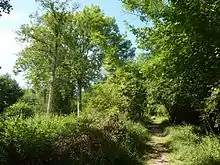 |
63 hectares (160 acres)[32] | Bury St Edmunds 52.19°N 0.83°E TL937580 |
YES | NNR,[33][32] SSSI[34] | These woods have a history of coppicing dating to before 1252, producing a very high diversity of flora, with over 370 plant species recorded. Uncommon woodland flowers include oxlip, herb paris and ramson. There is also a rich variety of fungi, with two species not recorded elsewhere in Britain.[35] |
| Bromeswell Green[36] |  |
7.2 hectares (18 acres) | Woodbridge 52.105°N 1.351°E TM296505 |
YES | This site has woodland, saltmarsh and wet meadows. Wetland plants include lesser spearwort, fen bedstraw and southern marsh orchid, the woodland has birds such as nightingales and whitethroats, and rides have many species of butterfly.[36] | |
| Brooke House[37] |  |
Not available |
Ipswich 52.143°N 1.189°E TM182541 |
YES | Brooke House is the headquarters of the Suffolk Wildlife Trust. It was left to the trust by Mary Brooke. It has gardens with fruit trees and a pond, where water voles have been observed.[37] | |
| Bull's Wood[38] |  |
12 hectares (30 acres) | Bury St Edmunds 52.159°N 0.803°E TL918549 |
YES | SSSI[39] | Flora in this wood include early-purple orchids, herb-paris and the uncommon oxlips. There are roe deer, marsh tits, and butterflies such as gatekeepers, speckled woods and orange tips.[38] |
| Captain's Wood[40] |  |
62 hectares (150 acres) | Sudbourne 52.12°N 1.54°E TM421531 |
YES | This site has woodland, rough grassland and scrub. A herd of fallow deer helps to keep the land open, and there are also barn owls, buzzards, mature oak trees and many bluebells.[40] | |
| Carlton and Oulton Marshes[41] |  |
151 hectares (370 acres) | Lowestoft 52.47°N 1.69°E TM509919 |
PP | Ramsar,[42][43] SAC,[44][45] SPA,[46][47] SSSI[48] | Semi-aquatic fen raft spiders were released on the site in 2012 to boost the low British population, and underwater insectiverous bladderworts trap water fleas. Birds of prey include marsh harriers, barn owls and hobbies, and there are many wintering wildfowl and breeding waders.[41] |
| Castle Marshes[49] |  |
71 hectares (180 acres) | Beccles 52.46°N 1.63°E TM470911 |
NO | Ramsar,[42][43] SAC,[44][45] SPA,[46][47] SSSI[50] | The site has fen, freshwater dykes and grazing marshes. Resident wildfowl include wigeons, gadwalls, teals and shovelers are joined in winter by migrants when the marshes are flooded. Scarce chaser and the nationally rare Norfolk hawker dragonflies breed on the site, and there are blue-tailed damselflies.[49] |
| Church Farm Marshes[51] | _and_Thorington_-_geograph.org.uk_-_74240.jpg.webp) |
56 hectares (140 acres) | Halesworth 52.31°N 1.55°E TM420742 |
YES | This site has areas of marshland, wet and dry woodland, and grassland. The flower-rich marshes have southern marsh orchid, marsh marigold and ragged robin. Grazing maintains diversity of flora in the meadows and marshes, ensuring a good population of insects, which provide food for birds.[51] | |
| Combs Wood[52] | 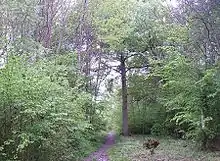 |
17 hectares (42 acres) | Stowmarket 52.171°N 0.999°E TM052568 |
YES | SSSI[53] | This is ancient coppice woodland on boulder clay, with variable quantities of sand and loess re-esulting in different soil types. In areas of pedunculate oak and hornbeam the ground flora is sparse, but it is rich and diverse in ash and maple woodland. Grassy rides and a pond provide additional habitats for invertebrates.[54] |
| Cornard Mere[55] |  |
6 hectares (15 acres) | Sudbury 52.014°N 0.747°E TL886386 |
YES | SSSI[56] | This site has diverse habitats, with fen which is seasonally flooded, ruderal herb vegetation, woodland, grassland and scrub. Flora include water mint, gypsywort, skullcap, ragged robin and southern marsh orchid.[56] |
| Darsham Marshes[57] |  |
20 hectares (49 acres) | Halesworth 52.268°N 1.545°E TM420692 |
YES | This marsh and fen site has two ponds and a network of dykes. The wildlife is diverse and flowering plants include ragged-robin, yellow flag, marsh marigold and southern marsh orchid. There are birds such as marsh harriers and hen harriers, and mammals include otters and water voles.[57] | |
| Dingle Marshes[58] |  |
93 hectares (230 acres) | Dunwich 52.28°N 1.63°E TM479708 |
YES | NCR,[59] NNR[60][33] Ramsar,[61] SAC,[62][63] SCHAONB,[15] SPA,[64][65] SSSI[66] | This site has the largest freshwater reedbeds in Britain. Other habitats are brackish pools, shingle, heath and woodland. There are otters and Exmoor ponies, and birds include bearded tits, bitterns, marsh harriers and grey plovers.[58] |
| Dunwich Forest[67] |  |
270 hectares (670 acres) | Dunwich 52.28°N 1.62°E TM467710 |
YES | The Trust is transforming this former conifer plantation into a mosaic of broad leaved woodland, lowland heath, acid grassland and wet woodland. Fauna include siskins, adders, noctule bats, red deer and white admiral butterflies.[67] | |
| Fox Fritillary Meadow[68] |  |
2.4 hectares (5.9 acres) | Stowmarket 52.202°N 1.201°E TM188607 |
NO | SSSI[69] | This unimproved meadow is located on heavy alluvial soils at the bottom of a valley. It has a rich variety of flora, including the herbs cowslip, cuckooflower and ragged robin, together with the largest population in East Anglia of the rare snake's head fritillary.[70] |
| Foxburrow Farm[71] |  |
67 hectares (170 acres) | Woodbridge 52.12°N 1.32°E TM274517 |
YES | Part of this site is a working farm which is managed by a tenant farmer, and it also has wildlife habitats and an education centre. Birds include little owls, spotted flycatchers and pied wagtails, and there are ponds with great crested newts.[71] | |
| Framlingham Mere[72] | 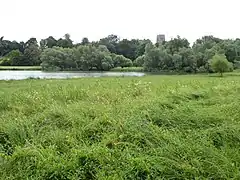 |
13.8 hectares (34 acres) | Framlingham 52.223°N 1.341°E TM283636 |
YES | This site has a lake and wet meadows adjoining Framlingham Castle. There are many migrating birds, and flora include marsh marigolds, ragged-robin and lady's smock.[72] | |
| Groton Wood[73] |  |
20 hectares (49 acres) | Hadleigh 52.048°N 0.88°E TL976428 |
YES | SSSI[74] | Fifteen species of butterfly have been recorded in this wood, including brimstones, speckled woods and purple hairstreaks. There are many wild cherry trees, and twenty-two seasonal ponds, which have scarce and protected great crested newts.[73] |
| Gunton Meadow[75] |  |
2 hectares (4.9 acres) | Lowestoft 52.503°N 1.738°E TM538960 |
YES | Gunton Meadow was saved from development as a planning condition for the expansion of a local supermarket. It has scrub, a pond and grassland. There are five species of orchid including the common spotted and green-winged, and great crested newts in the pond.[75] | |
| Gunton Warren[76] |  |
25 hectares (62 acres) | Lowestoft 52.5°N 1.754°E TM549958 |
YES | LNR[77] | Gunton Warren is a coastal site which has sand dunes, shingle, lowland heath and cliff slopes. Birds include rare migrants such as icterines and yellow-browed warblers.[76] |
| Hazlewood Marshes[78] |  |
64 hectares (160 acres) | Aldeburgh 52.17°N 1.57°E TM442582 |
YES | SSSI[79] | This was formerly a fresh water lagoon and marshes, but on 5 December 2013 a tidal surge broke through the sea wall and flooded the site with sea water. Whole communities of plants and invertebrates disappeared, and the site is converting to salt marsh, with birds including black-tailed godwits, dunlins, redshanks, lapwings and avocets.[78] |
| Hen Reedbeds[80] | 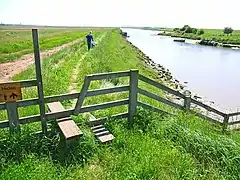 |
55 hectares (140 acres) | Southwold 52.34°N 1.63°E TM471771 |
YES | NNR,[33][81] Ramsar,[61] SCHAONB,[15] SSSI[66] | The reserve is a mix of wetland habitats, including reedbeds, fens, dykes and pools. It was designed to provide a breeding site for bitterns. Other fauna include marsh harriers, herons, bearded tits, four-spotted chaser dragonflies, hairy dragonflies, otters and water voles.[80] |
| Hopton Fen[82] |  |
15 hectares (37 acres) | Diss 52.378°N 0.922°E TL990796 |
YES | SSSI[83] | This reed-dominated fen has diverse flora, including devil's bit scabious, black bog-rush, bogbean and early marsh orchid. The Trust is improving the site by excavating new pools, and introducing grazing to restore the open landscape.[82][83] |
| Hutchison's Meadow[84] | 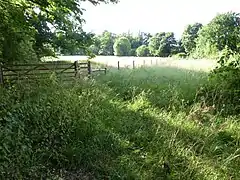 |
1 hectare (2.5 acres) | Woodbridge 52.103°N 1.328°E TM280502 |
NO | This is mixture of wet and dry grassland. It has diverse flowering plants such as southern marsh orchid, common fleabane and ragged robin in wet areas, and yellow rattle and bulbous buttercup in drier ones.[84] | |
| Knettishall Heath[85] |  |
176 hectares (430 acres) | Diss 52.39°N 0.89°E TL966806 |
YES | SSSI[86] | The site is heath and grassland, mainly on acidic soils, with areas of secondary woodland and wet hollows. There are heathland plants such as sheep's sorrel, tormentil, harebell and heath bedstraw, while wet areas have fen vegetation including water mint and yellow iris.[87] |
| Lackford Lakes[88] |  |
131 hectares (320 acres) | Bury St Edmunds 52.3°N 0.64°E TL800706 |
YES | SSSI[89] | The lakes are disused sand and gravel pits in the valley of the River Lark. There are diverse dragonfly species, and many breeding and overwintering birds, including nationally important numbers of gadwalls and shovellers. Skylarks breed on dry grassland, and lapwings in marshy meadows.[90] |
| Levington Lagoon[91] |  |
5 hectares (12 acres) | Ipswich 52.003°N 1.259°E TM238389 |
NO | This area of open water and saltmarsh on the bank of the River Orwell was formed when the sea wall was breached during the North Sea flood of 1953. The birds are diverse, including greenshanks, dunlins, spotted redshanks, pipits and dunlins. There are plants such as sea lavender.[91] | |
| Lound Lakes[92] | 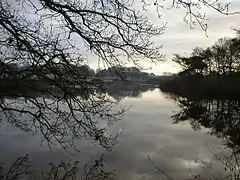 |
113 hectares (280 acres) | Great Yarmouth 52.55°N 1.7°E TG511007 |
YES | Habitats in this site include open water, woodland, grassland, rush pasture and fen meadow. More than 140 bird species have been recorded there, including hobbies, geese, ducks, reed warblers, gadwalls and oystercatchers. Brown long-eared and noctule bats are also present.[92] | |
| Market Weston Fen[93] |  |
37 hectares (91 acres) | Diss 52.372°N 0.912°E TL983789 |
YES | SAC,[94][95] SSSI[96] | This spring-fed valley fen has a high and stable water table, and as a result it has a rich and varied flora. The dominant plants in the central fen area are saw sedge, the reed Phragmites australis and blunt-flowered rush. Other habitats include tall fen grassland, heath and a stream. There are many dragonflies and damselflies.[96] |
| Martins' Meadows[97] | 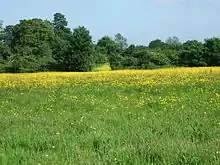 |
4 hectares (9.9 acres) | Woodbridge 52.168°N 1.254°E TM226572 |
YES | NCR,[98] SSSI[99] | This site has rich flora, and it is described by Natural England as probably the best example in the county of unimproved calcareous clay and neutral grassland. The herb species are especially diverse, including meadow saffron and green-winged orchid, and there are ancient fruit trees.[100] |
| Mellis Common[101] |  |
59 hectares (150 acres) | Eye 52.33°N 1.08°E TM100746 |
YES | The common has changed little over hundreds of years, and is still managed by traditional methods of grazing and hay cutting. Flora include green-winged orchid, sulphur clover and adder's tongue fern, and owls hunt small mammals.[101] | |
| Mickfield Meadow[102] |  |
1.7 hectares (4.2 acres) | Stowmarket 52.226°N 1.136°E TM143633 |
YES | SSSI[103] | Fertilisers and herbicides have never been used on this meadow, and as a result it has a rich variety of flora, including fritillary. The dominant grasses are meadow foxtail, cocksfoot, false oat-grass, timothy and Yorkshire fog.[104] |
| Mickle Mere[105] | 17 hectares (42 acres) | Bury St Edmunds 52.29°N 0.839°E TL937696 |
YES | This area of open water and wet meadows has diverse bird life such as lapwings, kestrels, little egrets and reed buntings, and mammals include water voles and otters.[105] | ||
| Newbourne Springs[106] |  |
19 hectares (47 acres) | Woodbridge 52.041°N 1.314°E TM274433 |
YES | SSSI[107] | Most of this site is a narrow valley with a fast-flowing stream with alder carr and fen. Drier and more acidic soils have grassland, woodland, scrub and bracken heath. The site is actively managed, producing diverse flora and many breeding and migratory birds such as treecreepers, nuthatches and sedge warblers.[106][108] |
| Norah Hanbury-Kelk Meadows[109] |  |
8 hectares (20 acres) | Bury St Edmunds 52.337°N 0.513°E TL713740 |
YES | These wet meadows and dykes have diverse flora, such as southern marsh orchids, lady's smock, early marsh orchid and greater bird's foot trefoil. Birds include snipe and ducks.[109] | |
| North Cove[110] |  |
15.5 hectares (38 acres) | Beccles 52.457°N 1.636°E TM471905 |
YES | Ramsar,[42][43] SAC,[44][45] SPA,[46][47] SSSI[50] | The site has wet woodland, grazing marsh, ponds and dykes. There are birds such as sparrowhawks, woodcocks, redpolls, siskins and the three species of woodpecker. Flora include opposite-leaved golden-saxifrage, bog pimpernel and the nationally scarce marsh fern.[110] |
| Old Broom[111] |  |
6.5 hectares (16 acres) | Bury St Edmunds 52.275°N 0.64°E TL802674 |
NO | This is a remnant of an ancient wood-pasture landscape with oak pollards between 250 and 500 years old. The dead wood and hollow centres of these trees provide a habitat for fungi and invertebrates, while the bark hosts mosses and lichens.[111] | |
| Papermill Reedbed[112] |  |
6 hectares (15 acres) | Ipswich 52.092°N 1.104°E TM127483 |
YES | The SWT has restored this area of dry grassland of low ecological value by installing water control measures to create wetland. Several species of dragonfly and damselfly have colonised the water-filled ditches, and they are used by water voles and otters.[112] | |
| Redgrave and Lopham Fens[113] |  |
163 hectares (400 acres) | Diss 52.38°N 1.01°E TM049796 |
YES | NCR,[114] NNR,[33][115] Ramsar,[116] SAC[94][95] SSSI[117] | This spring-fed valley at the head of the River Waveney has several different types of fen vegetation. There are aquatic plants such as bladderwort, fen pondweed and Charophytes, all of which are indicators of low levels of pollution. The site has the only British population of fen raft spiders.[117] |
| Reydon Wood[118] |  |
16 hectares (40 acres) | Southwold 52.351°N 1.64°E TM480788 |
YES | This conifer wood has many old ash and hornbeam stools. There are many wildflowers and birds, and butterflies such as ringlet, gatekeeper and orange tip.[118] | |
| Roydon Fen[119] |  |
17.2 hectares (43 acres) | Diss 52.375°N 1.085°E TM101797 |
YES | LNR[120] | This site was taken over by wet woodland in the twentieth century, but the SWT has restored the eastern end to fen by mowing, and it has many typical fen plants such as marsh helleborine, marsh fragrant orchid and sawsedge.[119] |
| Simpson's Saltings[121] | 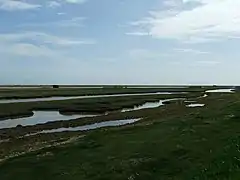 |
25 hectares (62 acres) | Woodbridge 52.055°N 1.474°E TM383453 |
NO | NCR,[10] Ramsar,[11][12] SAC,[13][14] SCHAONB,[15] SPA,[16][17] SSSI[18] | The Saltings are described by the Trust as "one of the county's most important coastal sites for its wealth of uncommon coastal and saltmarsh plants." There are also rare lichens. Habitats include intertidal mud, estuary creeks, saltmarsh, compacted sand and shingle.[121] |
| Sizewell Belts[122] | 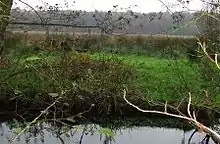 |
144 hectares (360 acres) | Leiston 52.22°N 1.59°E TM453639 |
YES | SCHAONB,[15] SSSI[123] | These unimproved wet meadows are described by Natural England as important for their outstanding assemblages of invertebrates, with many nationally rare and scarce species, and of national significance for its assemblage of breeding birds typical of wet grassland. The aquatic fauna is diverse, including the nationally scarce soft hornwort and fen pondweed.[124] |
| Snape Marshes[125] |  |
19.8 hectares (49 acres) | Saxmundham 52.165°N 1.501°E TM395576 |
FP | The diverse habitats in this reserve include reed-filled marshes, dry heath and mature oak woodland. It has all four reptiles found in the county, adders, common lizards, grass snakes and slowworms. Birds include barn owls, hobbies and marsh harriers, and freshwater dykes provide a habitat for otters.[125] | |
| Sutton and Hollesley Commons[126] |  |
400 hectares (990 acres) | Woodbridge 52.07°N 1.41°E TM335471 |
YES | SCHAONB,[15] SPA,[26] SSSI[127] | These remnants of the Sandlings Heaths[lower-alpha 3] consist of dry grass and heather heathland, together with areas of bracken, scrub and pine and birch woodland. Breeding birds include long-eared owls, and hen harriers roost there in the winter.[127] |
| Thelnetham Fen[129] |  |
8.8 hectares (22 acres) | Diss 52.368°N 0.961°E TM017786 |
YES | NCR,[130] SAC[94][95] SSSI[131] | This wet fen site has many wild flowers, including saw sedge, black bog rush and the rare grass-of-parnassus. Other habitats include wet woodland and reed beds along the bank of the River Little Ouse. The reed beds provide nesting sites for migrant birds such as sedge, grasshopper and reed warblers.[129] |
| Trimley Marshes[132] |  |
77 hectares (190 acres) | Felixstowe 51.97°N 1.29°E TM 262 355 |
YES | Ramsar,[133][134] SCHAONB,[15] SPA,[135][136] SSSI[137] | This site has a reservoir, islands, reedbeds and marshes. It has a rich variety and number of birds, such as redshankss, avocets, oystercatchers, little grebes and gadwalls.[132] |
| Wangford Warren[138] |  |
15 hectares (37 acres) | Brandon 52.426°N 0.586°E TL759840 |
PL | NCR,[139] SAC,[140] SPA,[141] SSSI[142] | This dry site has sand dunes and mounds which are stabilised by sand sedge and grasses. It is one of only two inland sites in Britain which has grey hair-grass, and other rare plants include shepherd's cress, bearded fescue and reindeer moss. Uncommon solitary bees and wasps burrow into sand.[138] |
| Winks Meadow[143] |  |
1.4 hectares (3.5 acres) | Stowmarket 52.369°N 1.382°E TM303799 |
YES | SSSI[144] | This meadow on a disused airfield is unimproved grassland, with a rich variety of flora on chalky boulder clay. There are many green-winged orchids, cowslips and pepper saxifrages.[144] The meadow is grazed by cattle or cut for hay to maintain the diversity of the wild flowers.[143] |
See also
- List of Sites of Special Scientific Interest in Suffolk
- National Nature Reserves in Suffolk
- List of Local Nature Reserves in Suffolk
Notes
- Some sites which are not open to the public are not listed on the SWT's website, and this article lists the 53 nature reserves which are listed by SWT.
- Unless otherwise stated, the area and location are taken from the Wildlife Trust page for each site.
- Sandlings Heaths are coastal heaths in Suffolk.[128]
References
- "What we do". Suffolk Wildlife Trust. Archived from the original on 14 August 2013. Retrieved 17 November 2017.
- "Contact us". Suffolk Wildlife Trust. Archived from the original on 20 February 2014. Retrieved 17 November 2017.
- About us Archived 14 August 2013 at the Wayback Machine, Suffolk Wildlife Trust. Retrieved 3 March 2014.
- "Map of Wildlife Trusts". The Wildlife Trusts. Archived from the original on 17 November 2017. Retrieved 17 November 2017.
- "Trustees' Reports and Financial Statements for the Year ended 31 March 2017" (PDF). Suffolk Wildlife Trust. Archived from the original (PDF) on 17 November 2017. Retrieved 17 November 2017.
- "Suffolk". British Services. Archived from the original on 8 May 2016. Retrieved 20 August 2017.
- "Population Estimates for UK, England and Wales, Scotland and Northern Ireland: Mid 2016". Office for National Statistics. Archived from the original on 15 February 2017. Retrieved 20 August 2017.
- "Borough, District, Parish and Town Councils". Suffolk County Council. Archived from the original on 27 May 2016. Retrieved 20 August 2017.
- "Alde Mudflats". Suffolk Wildlife Trust. Archived from the original on 26 April 2017. Retrieved 1 May 2017.
- Ratcliffe, A Nature Conservation Review, p. 9.
- "Information Sheet on Ramsar Wetlands: Alde–Ore Estuary" (PDF). Joint Nature Conservation Committee. Archived (PDF) from the original on 10 August 2017. Retrieved 4 May 2017.
- "Designated Sites View: Alde–Ore Estuary". Ramsar Site. Natural England. Archived from the original on 6 September 2017. Retrieved 5 May 2017.
- "Alde, Ore and Butley Estuaries". Special Areas of Conservation. Joint Nature Conservation Committee. Archived from the original on 31 July 2017. Retrieved 4 May 2017.
- "Designated Sites View: Alde, Ore and Butley Estuaries". Special Area of Conservation. Natural England. Archived from the original on 6 September 2017. Retrieved 5 May 2017.
- "Suffolk Coast & Heaths Area of Outstanding Natural Beauty Management Plan 2013–2018" (PDF). Suffolk Coast & Heaths AONB. p. 76. Archived (PDF) from the original on 15 August 2016. Retrieved 6 August 2016.
- "Alde–Ore Estuary". Special Protection Areas. Joint Nature Conservation Committee. Archived from the original on 2 August 2017. Retrieved 3 May 2017.
- "Designated Sites View: Alde–Ore Estuary". Special Protection Area. Natural England. Archived from the original on 6 September 2017. Retrieved 5 May 2017.
- "Designated Sites View: Alde–Ore Estuary". Sites of Special Scientific Interest. Natural England. Retrieved 2 May 2017.
- "Arger Fen and Spouse's Vale". Suffolk Wildlife Trust. Archived from the original on 26 April 2016. Retrieved 1 May 2017.
- "Wildlife at Arger Fen & Spouse's Vale". Suffolk Wildlife Trust. Archived from the original on 2 August 2017. Retrieved 4 May 2017.
- "Arger Fen". Local Nature Reserves. Natural England. 26 March 2013. Archived from the original on 28 April 2017. Retrieved 4 May 2017.
- "Designated Sites View: Arger Fen". Sites of Special Scientific Interest. Natural England. Archived from the original on 2 August 2017. Retrieved 4 May 2017.
- "Black Bourn Valley". Suffolk Wildlife Trust. Archived from the original on 9 August 2017. Retrieved 1 May 2017.
- "Blaxhall Common". Suffolk Wildlife Trust. Archived from the original on 26 April 2017. Retrieved 1 May 2017.
- Historic England. "Bowl Barrow on Blaxhall Common (1008485)". National Heritage List for England. Retrieved 4 May 2017.
- "Special Protection Areas under the EC Birds Directive. Sandlings" (PDF). Joint Nature Conservation Committee. Archived (PDF) from the original on 15 March 2016. Retrieved 4 May 2017.
- "Designated Sites View: Blaxhall Heath". Sites of Special Scientific Interest. Natural England. Archived from the original on 20 December 2016. Retrieved 4 May 2017.
- "Blaxhall Heath citation" (PDF). Sites of Special Scientific Interest. Natural England. Archived (PDF) from the original on 5 May 2015. Retrieved 23 May 2017.
- "Bonny Wood". Suffolk Wildlife Trust. Archived from the original on 3 August 2017. Retrieved 1 May 2017.
- "Designated Sites View: Barking Woods". Sites of Special Scientific Interest. Natural England. Retrieved 4 May 2017.
- "Bradfield Woods". Suffolk Wildlife Trust. Archived from the original on 13 May 2017. Retrieved 1 May 2017.
- "Designated Sites View: Bradfield Woods". National Nature Reserves. Natural England. Retrieved 5 May 2017.
- "Suffolk's National Nature Reserves". Natural England. Archived from the original on 25 April 2017. Retrieved 3 May 2017.
- "Designated Sites View: Bradfield Woods". Sites of Special Scientific Interest. Natural England. Retrieved 4 May 2017.
- "Bradfield Woods citation" (PDF). Sites of Special Scientific Interest. Natural England. Archived (PDF) from the original on 4 May 2015. Retrieved 23 May 2017.
- "Bromeswell Green". Suffolk Wildlife Trust. Archived from the original on 3 April 2016. Retrieved 1 May 2017.
- "Brooke House". Suffolk Wildlife Trust. Archived from the original on 14 June 2016. Retrieved 1 May 2017.
- "Bull's Wood". Suffolk Wildlife Trust. Archived from the original on 7 August 2017. Retrieved 1 May 2017.
- "Designated Sites View: Thorpe Morieux Woods". Sites of Special Scientific Interest. Natural England. Archived from the original on 7 August 2017. Retrieved 7 July 2017.
- "Captain's Wood". Suffolk Wildlife Trust. Archived from the original on 14 January 2017. Retrieved 1 May 2017.
- "Carlton and Oulton Marshes". Suffolk Wildlife Trust. Archived from the original on 28 April 2017. Retrieved 1 May 2017.
- "Information Sheet on Ramsar Wetlands (RIS): Broadland" (PDF). Joint Nature Conservation Committee. Archived (PDF) from the original on 10 August 2017. Retrieved 4 May 2017.
- "Designated Sites View: Broadland". Ramsar Site. Natural England. Retrieved 5 May 2017.
- "The Broads". Special Areas of Conservation. Joint Nature Conservation Committee. Archived from the original on 10 March 2016. Retrieved 4 May 2017.
- "Designated Sites View: The Broads". Special Area of Conservation. Natural England. Retrieved 7 May 2017.
- "Special Protection Areas under the EC Birds Directive. Broadland" (PDF). Joint Nature Conservation Committee. Archived (PDF) from the original on 15 March 2016. Retrieved 4 May 2017.
- "Designated Sites View: Broadland". Special Protection Area. Natural England. Retrieved 7 May 2017.
- "Designated Sites View: Sprat's Water and Marshes, Carlton Colville". Sites of Special Scientific Interest. Natural England. Archived from the original on 21 May 2017. Retrieved 7 May 2017.
- "Castle Marshes". Suffolk Wildlife Trust. Archived from the original on 26 April 2017. Retrieved 2 May 2017.
- "Designated Sites View: Barnby Broad & Marshes". Sites of Special Scientific Interest. Natural England. Archived from the original on 20 December 2016. Retrieved 4 May 2017.
- "Church Farm Marshes". Suffolk Wildlife Trust. Archived from the original on 3 August 2017. Retrieved 2 May 2017.
- "Combs Wood". Suffolk Wildlife Trust. Archived from the original on 24 October 2016. Retrieved 2 May 2017.
- "Designated Sites View: Combs Wood". Sites of Special Scientific Interest. Natural England. Retrieved 4 May 2017.
- "Combs Wood citation" (PDF). Sites of Special Scientific Interest. Natural England. Archived (PDF) from the original on 5 May 2015. Retrieved 23 May 2017.
- "Cornard Mere". Suffolk Wildlife Trust. Archived from the original on 3 April 2016. Retrieved 2 May 2017.
- "Designated Sites View: Cornard Mere, Little Cornard". Sites of Special Scientific Interest. Natural England. Retrieved 4 May 2017.
- "Darsham Marshes". Suffolk Wildlife Trust. Archived from the original on 12 May 2016. Retrieved 2 May 2017.
- "Dingle Marshes". Suffolk Wildlife Trust. Archived from the original on 3 August 2017. Retrieved 2 May 2017.
- Ratcliffe, A Nature Conservation Review, pp. 210–211.
- "Designated Sites View: Suffolk Coast". National Nature Reserves. Natural England. Retrieved 5 May 2017.
- "Information Sheet on Ramsar Wetlands (RIS): Minsmere–Walberswick" (PDF). Joint Nature Conservation Committee. Archived (PDF) from the original on 12 August 2017. Retrieved 4 May 2017.
- "Minsmere to Walberswick Heaths and Marshes". Special Areas of Conservation. Joint Nature Conservation Committee. Archived from the original on 3 August 2017. Retrieved 4 May 2017.
- "Designated Sites View: Minsmere to Walberswick Heaths & Marshes". Special Area of Conservation. Natural England. Retrieved 5 May 2017.
- "Special Protection Areas under the EC Birds Directive. Minsmere-Walberswick" (PDF). Joint Nature Conservation Committee. Archived (PDF) from the original on 16 March 2016. Retrieved 4 May 2017.
- "Designated Sites View: Minsmere-Walberswick". Special Protection Area. Natural England. Archived from the original on 3 August 2017. Retrieved 5 May 2017.
- "Designated Sites View: Minsmere-Walberswick Heaths and Marshes". Sites of Special Scientific Interest. Natural England. Retrieved 4 May 2017.
- "Dunwich Forest". Suffolk Wildlife Trust. Archived from the original on 8 December 2016. Retrieved 2 May 2017.
- "Fox Fritillary Meadow". Suffolk Wildlife Trust. Archived from the original on 28 April 2017. Retrieved 2 May 2017.
- "Designated Sites View: Fox Fritillary Meadow, Framsden". Sites of Special Scientific Interest. Natural England. Retrieved 8 May 2017.
- "Fox Fritillary Meadow citation" (PDF). Sites of Special Scientific Interest. Natural England. Archived (PDF) from the original on 5 May 2015. Retrieved 24 July 2017.
- "Foxburrow Farm". Suffolk Wildlife Trust. Archived from the original on 25 August 2016. Retrieved 2 May 2017.
- "Framlingham Mere". Suffolk Wildlife Trust. Archived from the original on 9 April 2017. Retrieved 2 May 2017.
- "Groton Wood". Suffolk Wildlife Trust. Archived from the original on 28 April 2017. Retrieved 2 May 2017.
- "Designated Sites View: Groton Wood". Sites of Special Scientific Interest. Natural England. Retrieved 10 May 2017.
- "Gunton Meadow". Suffolk Wildlife Trust. Archived from the original on 24 June 2016. Retrieved 2 May 2017.
- "Gunton Warren". Suffolk Wildlife Trust. Archived from the original on 28 April 2017. Retrieved 2 May 2017.
- "Gunton Warren and Corton Woods". Local Nature Reserves. Natural England. 26 March 2013. Archived from the original on 28 April 2017. Retrieved 8 May 2017.
- "Hazlewood Marshes". Suffolk Wildlife Trust. Archived from the original on 18 October 2016. Retrieved 2 May 2017.
- "Designated Sites View: Alde–Ore Estuary". Sites of Special Scientific Interest. Natural England. Archived from the original on 6 September 2017. Retrieved 12 May 2017.
- "Hen Reedbeds". Suffolk Wildlife Trust. Archived from the original on 12 January 2014. Retrieved 2 May 2017.
- "Designated Sites View: Suffolk Coast". National Nature Reserves. Natural England. Retrieved 4 May 2017.
- "Hopton Fen". Suffolk Wildlife Trust. Archived from the original on 4 July 2016. Retrieved 2 May 2017.
- "Designated Sites View: Hopton Fen". Sites of Special Scientific Interest. Natural England. Retrieved 10 May 2017.
- "Hutchison's Meadow". Suffolk Wildlife Trust. Archived from the original on 1 June 2016. Retrieved 2 May 2017.
- "Knettishall Heath". Suffolk Wildlife Trust. Archived from the original on 3 March 2017. Retrieved 2 May 2017.
- "Designated Sites View: Knettishall Heath". Sites of Special Scientific Interest. Natural England. Retrieved 10 May 2017.
- "Knettishall Heath citation" (PDF). Sites of Special Scientific Interest. Natural England. Archived (PDF) from the original on 4 May 2015. Retrieved 25 May 2017.
- "Lackford Lakes". Suffolk Wildlife Trust. Archived from the original on 6 July 2017. Retrieved 2 May 2017.
- "Designated Sites View: Lackford Lakes". Sites of Special Scientific Interest. Natural England. Retrieved 10 May 2017.
- "Lackford Lakes citation" (PDF). Sites of Special Scientific Interest. Natural England. Archived (PDF) from the original on 4 May 2015. Retrieved 25 May 2017.
- "Levington Lagoon". Suffolk Wildlife Trust. Archived from the original on 14 August 2017. Retrieved 2 May 2017.
- "Lound Lakes". Suffolk Wildlife Trust. Archived from the original on 3 August 2017. Retrieved 2 May 2017.
- "Market Weston Fen". Suffolk Wildlife Trust. Archived from the original on 16 April 2016. Retrieved 2 May 2017.
- "Waveney and Little Ouse Valley Fens". Special Areas of Conservation. Joint Nature Conservation Committee. Archived from the original on 3 August 2017. Retrieved 4 May 2017.
- "Designated Sites View: Waveney & Little Ouse Valley Fens". Special Area of Conservation. Natural England. Retrieved 10 May 2017.
- "Designated Sites View: Weston Fen". Sites of Special Scientific Interest. Natural England. Retrieved 4 May 2017.
- "Martins' Meadows". Suffolk Wildlife Trust. Archived from the original on 3 April 2016. Retrieved 2 May 2017.
- Ratcliffe, A Nature Conservation Review, p. 40.
- "Designated Sites View: Monewden Meadows". Sites of Special Scientific Interest. Natural England. Retrieved 4 May 2017.
- "Monewden Meadows citation" (PDF). Sites of Special Scientific Interest. Natural England. Archived (PDF) from the original on 4 May 2015. Retrieved 6 June 2017.
- "Mellis Common". Suffolk Wildlife Trust. Archived from the original on 3 August 2017. Retrieved 2 May 2017.
- "Mickfield Meadow". Suffolk Wildlife Trust. Archived from the original on 3 April 2016. Retrieved 2 May 2017.
- "Designated Sites View: Mickfield Meadow". Sites of Special Scientific Interest. Natural England. Retrieved 10 May 2017.
- "Mickfield Meadow citation" (PDF). Sites of Special Scientific Interest. Natural England. Archived (PDF) from the original on 7 April 2014. Retrieved 2 June 2017.
- "Mickle Mere". Suffolk Wildlife Trust. Archived from the original on 3 August 2017. Retrieved 2 May 2017.
- "Newbourne Springs". Suffolk Wildlife Trust. Archived from the original on 2 October 2016. Retrieved 2 May 2017.
- "Designated Sites View: Newbourn (sic) Springs". Sites of Special Scientific Interest. Natural England. Retrieved 10 May 2017.
- "Newbourn (sic) Springs citation" (PDF). Sites of Special Scientific Interest. Natural England. Archived (PDF) from the original on 5 May 2015. Retrieved 6 June 2017.
- "Norah Hanbury–Kelk Meadows". Suffolk Wildlife Trust. Archived from the original on 3 August 2017. Retrieved 2 May 2017.
- "North Cove". Suffolk Wildlife Trust. Archived from the original on 26 April 2017. Retrieved 2 May 2017.
- "Old Broom". Suffolk Wildlife Trust. Archived from the original on 15 May 2016. Retrieved 2 May 2017.
- "Papermill Reedbed". Suffolk Wildlife Trust. Archived from the original on 21 August 2017. Retrieved 2 May 2017.
- "Redgrave and Lopham Fen". Suffolk Wildlife Trust. Archived from the original on 3 March 2017. Retrieved 2 May 2017.
- Ratcliffe, A Nature Conservation Review, p. 214.
- "Designated Sites View: Redgrave and Lopham Fen". National Nature Reserves. Natural England. Retrieved 5 May 2017.
- "Information Sheet on Ramsar Wetlands (RIS): Redgrave and South Lopham Fens" (PDF). Joint Nature Conservation Committee. Archived (PDF) from the original on 8 August 2017. Retrieved 4 May 2017.
- "Designated Sites View: Redgrave and Lopham Fens". Sites of Special Scientific Interest. Natural England. Retrieved 10 May 2017.
- "Reydon Wood". Suffolk Wildlife Trust. Archived from the original on 3 August 2017. Retrieved 2 May 2017.
- "Roydon Fen". Suffolk Wildlife Trust. Archived from the original on 3 April 2016. Retrieved 2 May 2017.
- "Roydon Fen". Local Nature Reserves. Natural England. 22 March 2013. Archived from the original on 4 March 2016. Retrieved 3 July 2017.
- "Simpson's Saltings". Suffolk Wildlife Trust. Archived from the original on 3 August 2017. Retrieved 2 May 2017.
- "Sizewell Belts". Suffolk Wildlife Trust. Archived from the original on 3 April 2016. Retrieved 2 May 2017.
- "Designated Sites View: Sizewell Marshes". Sites of Special Scientific Interest. Natural England. Retrieved 2 May 2017.
- "Sizewell Marshes citation" (PDF). Sites of Special Scientific Interest. Natural England. Archived (PDF) from the original on 5 May 2015. Retrieved 7 June 2017.
- "Snape Marshes". Suffolk Wildlife Trust. Archived from the original on 1 June 2016. Retrieved 2 May 2017.
- "Sutton and Hollesley Commons". Suffolk Wildlife Trust. Archived from the original on 1 June 2016. Retrieved 2 May 2017.
- "Designated Sites View: Sutton and Hollesley Heaths". Sites of Special Scientific Interest. Natural England. Retrieved 10 May 2017.
- "Sandlings Heaths and Forests". The Wildlife Trusts. Archived from the original on 12 September 2015. Retrieved 1 December 2017.
- "Thelnetham Fen". Suffolk Wildlife Trust. Archived from the original on 22 November 2016. Retrieved 2 May 2017.
- Ratcliffe, A Nature Conservation Review, pp. 214–215.
- "Designated Sites View: Blo' Norton and Thelnetham Fens". Sites of Special Scientific Interest. Natural England. Retrieved 5 July 2017.
- "Trimley Marshes". Suffolk Wildlife Trust. Archived from the original on 3 August 2017. Retrieved 2 May 2017.
- "Information Sheet on Ramsar Wetlands (RIS): Stour and Orwell Estuaries" (PDF). Joint Nature Conservation Committee. Archived (PDF) from the original on 10 October 2012. Retrieved 4 May 2017.
- "Designated Sites View: Stour and Orwell Estuaries". Ramsar Site. Natural England. Retrieved 10 May 2017.
- "Special Protection Areas under the EC Birds Directive. Stour and Orwell Estuaries" (PDF). Joint Nature Conservation Committee. Archived (PDF) from the original on 15 March 2016. Retrieved 4 May 2017.
- "Designated Sites View: Stour and Orwell Estuaries". Special Protection Area. Natural England. Retrieved 10 May 2017.
- "Designated Sites View: Orwell Estuary". Sites of Special Scientific Interest. Natural England. Retrieved 2 May 2017.
- "Wangford Warren". Suffolk Wildlife Trust. Archived from the original on 15 May 2016. Retrieved 2 May 2017.
- Ratcliffe, A Nature Conservation Review, p. 134.
- "Breckland". Special Areas of Conservation. Joint Nature Conservation Committee. Archived from the original on 3 March 2016. Retrieved 4 May 2017.
- "Special Protection Areas under the EC Birds Directive. Breckland" (PDF). Joint Nature Conservation Committee. Archived (PDF) from the original on 15 March 2016. Retrieved 4 May 2017.
- "Designated Sites View: Wangford Warren and Carr". Sites of Special Scientific Interest. Natural England. Retrieved 10 May 2017.
- "Winks Meadow". Suffolk Wildlife Trust. Archived from the original on 3 April 2016. Retrieved 2 May 2017.
- "Designated Sites View: Metfield Meadow". Sites of Special Scientific Interest. Natural England. Retrieved 11 May 2017.
Sources
- Ratcliffe, Derek, ed. (1977). A Nature Conservation Review. 2. Cambridge, UK: Cambridge University Press. ISBN 978-0-521-21403-2.
| Wikimedia Commons has media related to Suffolk Wildlife Trust. |